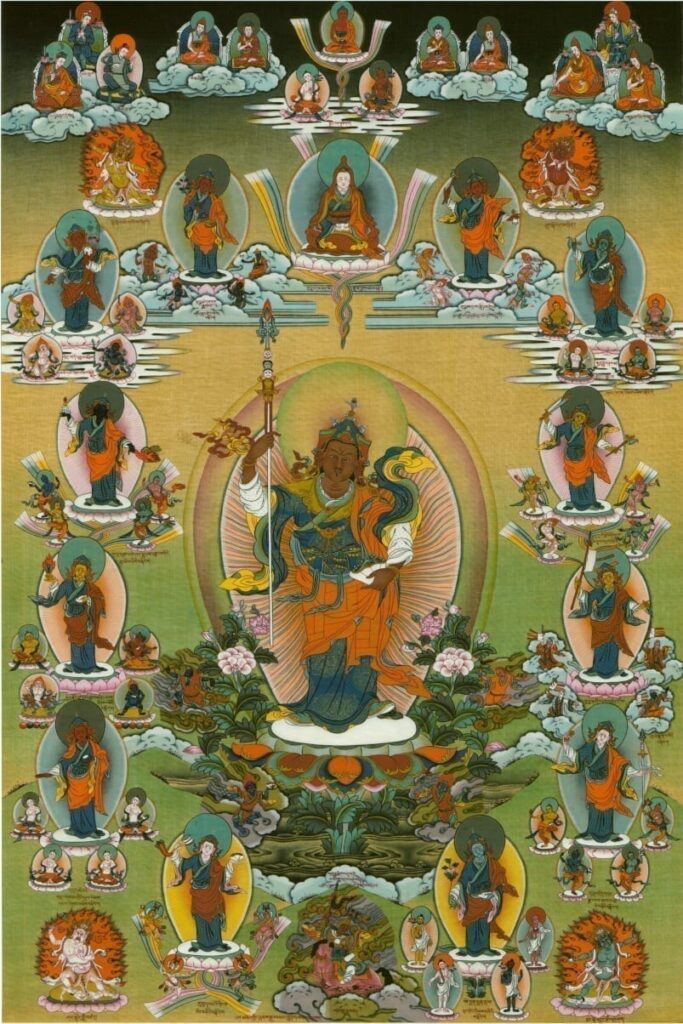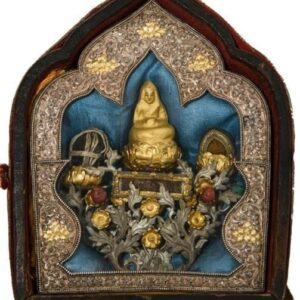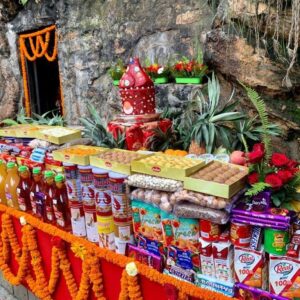It is mentioned in the Lamrim Yeshe Nyingpo, The Gradual Path of the Wisdom Essence, by Guru Rinpoche that there are four levels of heart-practice or guru sadhanas: the outer is Barché Künsel, the inner is Sampa Lhündrup, the secret is Tsokyé Nyingtik, and the innermost secret is Dorjé Draktsal. The terma or treasure root text states:
Externally, in order to dispel all obstacles, ༔
by means of Nangsi Zilnön, the trikāya Padmākara, ༔
with the twelve manifestations of vidyādhara power-wielders, ༔
practice the approach in the general and special manners. ༔Internally, in order to spontaneously accomplish supreme and common wishes, ༔
by means of Wish-fulfilling Great Bliss, Padmasambhava, ༔
together with the thirteen gurus, ༔
make the full approach of means and liberation, development and completion. ༔Secretly, by means of indivisible space and awareness ༔
manifest in the mudra form as Padma Vajradhara, ༔
all the three roots condensed, and through the essence yoga, ༔
gain accomplishment of the unchanging coemergent wisdom. ༔Most secretly, by means of Vidyādhara Dorjé Drakpo Tsel, ༔
Lamrim Yeshe Nyingpo, trans. Erik Pema Kunsang, ed. Marcia Dechen Wangmo. Rangjung Yeshe Publications: Hong Kong, 2016.
the embodiment of all sugatas, the deity who has totally perfected all herukas, ༔
and through the nyegyü practice, the great accomplishment, ༔
realize the ultimate kāyas and wisdoms. ༔
Significance
In the inner practice of Sampa Lhündrup, the Spontaneous Fulfillment of All Wishes, Guru Rinpoche appears in a standing posture—ready to act—surrounded by his twelve emanations. In this form, the Mahaguru grants the practitioners protection from all calamities. He guards us against conflict, disease, poverty, obstacle-makers, vicious animals, disturbances of the four natural elements, robbers, sudden death, the intermediate state, clinging to reality, and the sufferings of the six classes of beings.
History
The Sampa Lhündrup terma or treasure text states that on one very special occasion, Guru Rinpoche’s closest disciples requested the Mahaguru to make a kutsap, or a physical representation of his vajra body for the benefit of all beings. Fulfilling their request:
With his miraculous powers, Guru Padma travelled as swift as lightning ༔
to all the Buddha-fields of the ten directions, infinite in number, ༔
and gathered all the blessings held in supreme images and other supports of blessing, ༔
into a single casket of light. ༔Placing this casket in the center of the great mandala of their practice, ༔
he directed his vajra gaze to bless it with his wisdom mind. ༔Instantly, the casket transformed into a mound of amrita. ༔
To make the statue, he used clay mixed with this amrita, as well as ༔
jewels from Lake Manasarovar and Atrong stucco—both extremely rare in the human world—, ༔
and earth from all the sacred places and lands, and from the charnel grounds. ༔Again, he directed his mind to bless it; ༔
Rays of light blazed in every direction, concentrating ༔
the wisdom and blessing of all the sugatas and their heirs. ༔The kaya of great bliss shone onto the world, ༔
the mere thought of which set it ablaze with the glory of siddhis. ༔
Given the extraordinary circumstances under which the statue was made, it became a wish-fulfilling jewel, fulfilling every aspiration made in front of it and planting the seed of liberation in anyone who sees it. The kutsap was named Ngödrup Palbar, Glorious Blazing Siddhi, and it is regarded as one of the most sacred kutsaps of Guru Rinpoche. Later, Khandro Yeshé Tsogyal hid this extraordinarily sacred wish-fulfilling statue together with the Sampa Lhündrup teachings written in seven syllables in Dakini script and other precious practices and teachings by Guru Rinpoche.1The full translation of the history of the Kutsap Ngödrup Palbar statue can be found here: http://blog.xuite.net/yeshi_tsogyal/twblog/519247964
Revelation
Orgyen Tobgyal Rinpoche recounts:
Chokgyur Lingpa once had a vision of Jamyang Khyentsé as inseparable from Guru Rinpoche. Light came blazing forth from his eyes to touch a rock in Kela called Norbu Pünsum. A big image of Guru Rinpoche appeared on the rock, together with seven letters in symbolic script. Meanwhile, Jamyang Khyentsé was having a vision of Guru Rinpoche pointing at the same rock in Kela. He sent a man to Chokgyur Lingpa with the message that a terma was concealed there and asked him to bring it back to him. This terma was the Sampa Lhündrup, and with it was a small statue called Glorious Blazing Siddhi (Ngödrub Palbar). Even someone who has committed one of the five inexpiable evil deeds will be liberated upon seeing it. Chokgyur Lingpa gave it to Khyentsé, since he was the rightful owner. Also revealed were seven symbolic letters, from which he wrote down the Tukdrup Yizhin Norbu Sampa Lhündrup. The sixth of these symbolic letters was an inexhaustible source of terma teachings. The statue, terma box and symbolic letters remain in Bir, in India, and can still be seen today.
The Life of Chokgyur Lingpa as told by Orgyen Tobgyal Rinpoche, trans. Tulku Jigme Khyentse and Erik Pema Kunsang. Rangjung Yeshe Publications.
An Explanation of the Sampa Lhündrup Tsok Prayer by Phakchok Rinpoche
For the Sampa Lhündrup Tsok, Tsewang Drakpa, the second son of Chokgyur Lingpa, composed a short tsok prayer, which we will be using for the tsok bum on the upcoming Guru Rinpoche day. Although composed by Tsewang Drakpa, this prayer is actually a terzhung, meaning a teaching written by Guru Rinpoche himself. In composing it, therefore, Tsewang Drakpa didn’t actually write it, but just extracted it from the main sadhana text.
Now, this particular tsok offering will help us accumulate merit very swiftly. The Buddha himself said when a practitioner accumulates merit, then as a result that person’s wishes will be fulfilled. And I really think this is true. Whether you are involved in mundane issues, normal life, or spiritual activity, you really need to accumulate merit. And the Vajrayana way to accumulate merit, the faster way, is by means of tsok or feast offering.
The word for “feast offering” in Sanskrit is ganachakra, which translates into Tibetan as tsok kyi khorlo, the circle of offerings. Gathering the two accumulations of merit and wisdom is the supreme and indispensable method for clearing away the cloud of obscurations that prevent us from realizing our buddha-nature. And the practice of feast offerings is one of the most skillful ways to swiftly gather accumulations while also purifying our obscurations and mending our broken samayas.
Many of Guru Rinpoche’s treasure teachings say that performing feast offerings generates tremendous merit. There have been many instances when Guru Rinpoche himself appeared in person during feast offerings and blessed the practitioners who were calling upon him with unwavering devotion.
When you perform the tsok or feast offering, it is very important to visualize yourself as not separate from Guru Rinpoche, and to visualize Guru Rinpoche’s mandala in front of you. Understand that Guru Rinpoche’s mandala includes the mandalas of all the buddhas and that all gurus are actually inseparable within that mandala. In the Vajrayana there is a saying: Offering just one thing to the guru is equal to making offerings to all thousand buddhas.
It is important to understand that the feast offering combines many practices into one: Feast offering means generosity. Feast offering means guru yoga. Feast offering means mandala offering. Feast offering means confession. Feast offering means repairing our broken samaya. You see, in a tsok or feast offering all are included. It’s confession because we say, “I offer this, I confess all my misdeeds, my problems, my bad karma.” It’s generosity because it’s an offering, and it’s a mandala offering because we include the wisdom offering. It’s guru yoga because we make the offering to the guru. You can also see all of these reflected in this short Sampa Lhündrup tsok prayer by Tsewang Drakpa:
om ah hung
Oṃ āḥ hūṃ actually meaning bless the offering, multiply the offering, and transform the offering into wisdom. That is the actual meaning of oṃ āh hūṃ. The syllables oṃ āh hūṃ are very special because each has multiple meanings. Most importantly, though, oṃ represents the Buddha’s body, āḥ represents the Buddha’s speech, and hūṃ represents the Buddha’s heart.
When you write oṃ, you see “a” and “o” and a circle, making oṃ. When they write “a,” it represents the dharmakāya, the “o” represents the sambhogakāya, and the circle is the nirmāṇakāya. Thus, oṃ represents the three kāyas.
Regarding āḥ, the Mañjuśrī-Nāmasaṃgīti, Chanting the Names of Manjuśrī, actually says: “The syllable āḥ is the most supreme syllable, the highest syllable—āḥ.”
The syllable āḥ means unborn. When you say āḥ it’s very natural, you don’t need to change your mouth position. “Aaaah” is very natural. That means it’s uncontrived. Uncontrived means not made up. That’s why it’s natural. The āḥ sound is in every syllable. That’s why āḥ is the universal sound. Therefore, all the syllables and sounds originate from āḥ. The meaning of āḥ is unborn. The sound of āḥ is unchanged by the mouth, it is natural. The really deep meaning is unborn. And the idea is that āḥ is all-pervasive. Śūnyatā, emptiness pervades everything. With this one single sound, everything is included.
When you write hūṃ you have ha. The ha sound represents clinging. The “u” and “m” sounds represent non-clinging. So, the Buddha’s heart actually means no clinging. That’s hūṃ in essence.
Then you say:
lama rikdzin tsa sum kyilkhor lha
dir shek tsok kyi chö bül gyé kang télama—guru, that is Guru Rinpoche
rikdzin—all lineage masters
tsa sum—the three roots: Guru, Yidam, Ḍākinī.
kyilkhor lha—all the mandalas
dir shek—please come here
dir shek tsok kyi chö bül gyé kang té—Today I’m going to do a big elaborate tsok offering, thus: “Come here and joyfully partake of this gathering offering!”
When you recite “lama rikdzin tsa sum kyilkhor lha, dir shek tsok kyi chö bül gyé kang té” this means “all you gurus please come here.” When you request them to “please come,” there are three reasons why they actually will: The first is devotion, that is to say, “all you mandalas please come, I think of you.” The second is the commitment that the deities have to come when invoked. The third is that ultimately all the gurus are already here from the very beginning—you simply need to understand that they are actually here.
Next you say:
nyamchak töl shak dra gek drelwa yi
nyamchak töl shak—With “we confess our transgressions,” you confess all broken samaya and bad karma. töl shak means “we confess.”
dra gek—Actually, dra is our ego, or ego-clinging. Although dra is our ego, it also can be understood as our enemy, or māra. That is, māra, our enemy, is ego.
Gek—These are our negative emotions. It is said that spirits roam around outside because we have emotions inside. Therefore, the reason we will see big māras outside is because we have ego.
Drelwa—We liberate these enemies and obstructers.
Then comes:
sha trak zhel top lhak la wangwé röl
sha trak zhel top—Addresses the wrathful deities and dharma protectors. They require an offering of blood and flesh. Trak, blood, here actually means desire. And, sha, flesh, actually means ignorance. Human beings’ biggest afflictions, the worst ones, are desire and ignorance. They cause suffering all the time.
drelwa yi sha trak zhel top—Once the enemies and obstructers are liberated their remains are offered to the wrathful deities and dharma protectors.
lhak la wangwé röl—This addresses the deities that remain at the edges of or outside the mandala. They too partake in the feast offering. We offer lhak, the remainder, to them. Therefore, after we finish the feast offering, we place the lhagma, the leftover or remainder, outside.
Then:
chi nang sangwé barché zhiwa dang
sampa lhün gyi drupar dzé du sölchi nang sangwé barché—outer, inner, and secret obstacles. Outer obstacles are, for example, family and business issues. Inner obstacles concern our nadi, prana, and bindu. In other words, they are bodily illnesses. Secret obstacles affect our emotions, thoughts, and dharma practice.
Zhiwa—pacify them
Dang—and
sampa lhün gyi drupar dzé du söl—Please bless us and “spontaneously fulfill all wishes!” Here “fulfill all wishes” has many meanings. For example, fulfill my wish to benefit sentient beings. Fulfill my wish to succeed in whatever we wish to accomplish. Fulfill my wish to achieve enlightenment in this lifetime.
Then comes the mantra:
om ah hum sarva mahaguru mandala saparivara ganatsakra pudza khahi | utsishta balingta bhakshasi soha ||
I’ve explained the meaning of om ah hum before.
sarva mahaguru—all maha guru
mandala saparivara—and all the deities
ganatsakra pudza—the circle of offerings
Khahi—we offer
utsishta balingta bhakshasi soha—We offer the remainder offering.
Thus, please fulfill all our wishes!
So, this is the short tsok offering prayer.
Translations
简体中文
Bahasa Indonesia
Español
Português
नेपाली
Українська
Việt Ngữ




